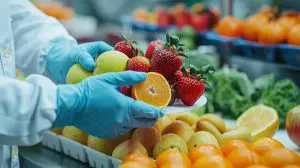This year, due to the Covid-19 pandemic, the SQF Institute will be hosting its annual SQF Conference online. The food safety event which will be held from October 27 to 29, 2020, will be able to reach SQF practitioners in 40 countries. This is a great opportunity for students to participate (a ticket costs 99 USD with proof of student ID).
One of the sessions will be focusing on the imminent release of Edition 9. The revised SQF code is anticipated to be available in early October 2020, and implementation will start May 2021.
While we await the official release of the SQF Code Edition 9, we already know some of the key proposed changes. These changes pertain to compliance with the new 2020 GFSI Benchmarking requirements (BR8). For those of you who are new to SQF and unfamiliar with the Global Food Safety Initiative, GFSI requirements are “aligned with Codex Alimentarius” and “enable a common understanding and mutual trust in the supply chain that facilitates trade, improves efficiency and lends nameplate authority to operations certified to a GFSI-recognised programme” (GFSI, 2020).
Version 2020 of the GFSI benchmarking requirements puts the emphasis on “transparency and objectivity” to ensuring global food safety. One key highlight is the importance of developing and measuring elements of a food safety culture within an organisation.
GFSI initiated discussion on the Food Safety Culture theme in 2015. Their technical working group subsequently released a white paper in late 2018 gathering feedback from leading practitioners and scientists. Their stance on the subject was that food safety legislation would not be able to solely promote the “habitual and systematic” habits necessary to ensure food safety within a food business. Instead, they advocate that elements of a food safety culture must include strong leadership from management, effective communication, employee training strategies and demonstrated responsiveness in managing change and assessing risks.
How is your food business able to gauge its food safety culture?
As the food safety leader in your organisation, consider the following:
- Do you have a food safety management policy? Is the management team able to articulate your company’s food safety expectations? What is your business strategy towards achieving food safety commitments? How do you keep informed about emerging threats and regulatory changes (e.g. Covid-19)? Can you recall the last time you were proactive and implemented a new preventive control that was instrumental in achieving food safety compliance quickly?
- Is your employee training program effective? What are the methods you use to create awareness about food safety? Do employees and their direct supervisors understand the importance of implementing a robust food safety plan? Do your people understand the consequences of a plan failure and what it would mean for your customers and your business? Do you encourage staff to report food safety incidents and near-misses? How do you use these opportunities towards continuous improvement?
Proposed Strategies for Food Safety Culture Improvements (Learning maturity levels 1 through 5)
(Adapted from GFSI A culture of food safety, a position paper, 2018)
| Education and Training of Senior Management | ||||
| Level 1 –
Implement basic training on food safety fundamentals for senior management. Link responsibilities to job descriptions.
|
Level 2 –
Develop systems around food safety training and measure training effectiveness. Provide basic and advance training (e.g. CCP training). Communicate often with senior management on the facility’s food safety performance.
|
Level 3 –
Refine training programs. Measure senior management confidence in implementing food safety initiatives and communicating with staff. Provide resources and budgets for food safety. Include senior management in food safety discussions (e.g. food safety plan reviews, facility’s upgrades). |
Level 4 – Increased communication around food safety and risk prevention. Provide opportunities for senior management to attend food safety talks and other risk management events. | Level 5 –
Sustained and up-to-date communication around food safety. Development of an employee recognition and rewards program. Training programs are updated frequently. Senior management is active in promoting supply chain improvements (e.g. supporting supplier’s improvements). |
| Education and Training of Middle Management/Supervisory Staff | ||||
| Level 1 – Implement food safety training for supervisory personnel. Link concepts to practical applications. Foster communication with senior management. | Level 2 – Develop systems around food safety training and measure training effectiveness. Make food safety training, communication and practices part of the supervisor’s job description. Senior management is instrumental in setting expectations for food safety practices. | Level 3 – Refine training programs for supervisors, provide more in-depth training about food safety risks, tailor training to the business. Focus on communication and establish employee recognition/rewards program.
|
Level 4 – Continual coaching and support of supervisors who become food safety trainers. Provide opportunities for onsite and off-site training on food safety risk management. Established rewards program. | Level 5 – Senior management fosters continuous improvement of supervisors’ technical and behavioural skills. Training programs are updated regularly.
|
| Education and Training of Food Handlers | ||||
| Level 1 – Implement food safety training at onboarding and refresher training annually. Ensure all employees receive GMP training. Measure the effectiveness of training by administering quizzes and observing employee practices.
Adapt the training to level of education and fluency in English. Use training aids such as videos and images to convey concepts.
|
Level 2 – Increase the depth and frequency of training based on food safety awareness and food safety risks (e.g. offer GMP refresher training twice a year). Customise the training to the operations. Explain the reasons for preventive measures. Document the training and its effectiveness. | Level 3 – Implement a rewards program when preventive controls are consistently practiced. Recognise employees who follow GMP practices consistently. | Level 4 – Provide continuing support and coaching for employees to take ownership of their job (conducting pre-operational inspections, placing food and materials on hold when specifications deviate from requirements, joining the food safety team, etc.) | Level 5 – Build trust to encourage employees to provide feedback and to report on near misses.
Help employees promote food safety amongst their peers. Create a rewards and employee recognition program, facilitate the promotion of talent to supervisory positions through constant communication of food safety objectives. |
The Covid-19 pandemic has drastically changed the way food businesses operate and address health risks. The need to implement social distancing policies has created opportunities for online learning. It is becoming easier for middle managers and senior management to attend training alongside front-line employees. This is a good first step to developing a food safety culture within one organisation.
Certification bodies and other organisations are now providing instructor-led courses via Zoom. The use of breakout rooms facilitates learning and engagement. To find out more and if you are interested in HACCP, SQF or PCQI training for yourself and your team, Contact us or check the SAI Global website for a list of online training options.
For more information about creating a food safety culture within your organisation, read our earlier blog post on the subject.
Reference:
SQFI 2020 conference
GFSI 2020 Benchmarking requirements
GFSI White Paper – Food Safety Culture (2018)





